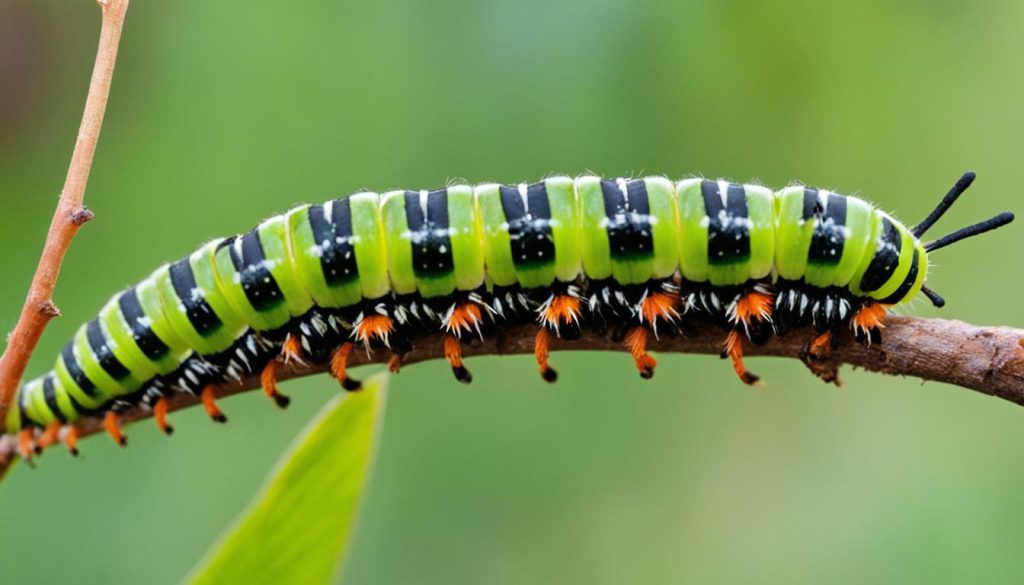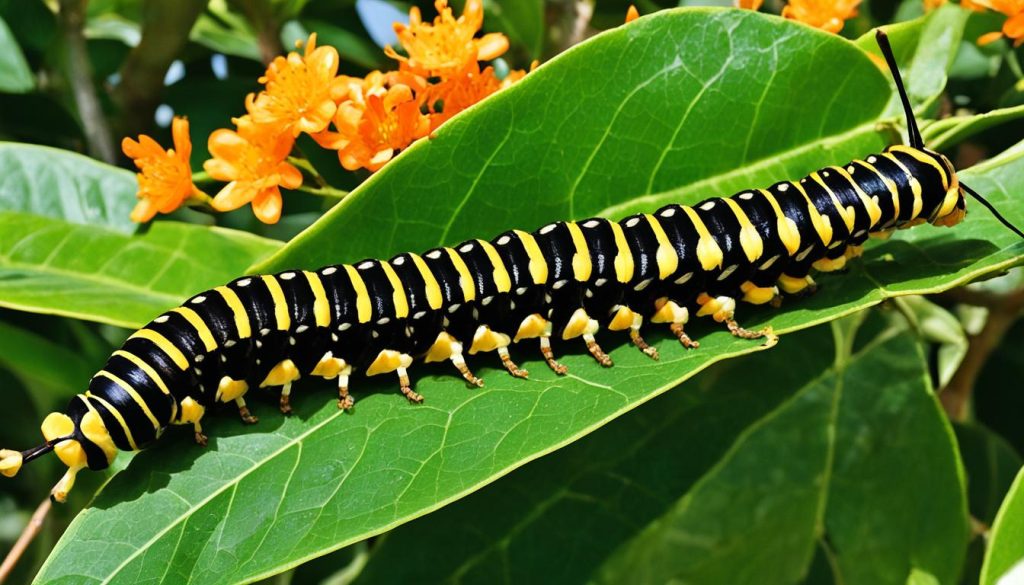The giant swallowtail caterpillar, also known as Papilio cresphontes, is the largest butterfly caterpillar in North America. With a wingspan of up to 6 1/4 inches, it is truly a remarkable sight in the wild. But what makes this caterpillar even more fascinating is its unique appearance and its important role in butterfly conservation efforts.
The giant swallowtail caterpillar’s distinctive markings resemble bird droppings, providing it with camouflage against predators. This clever adaptation allows the caterpillar to blend in seamlessly with its surroundings, ensuring its survival in nature. But beyond its clever disguise, the giant swallowtail caterpillar contributes significantly to butterfly conservation by pollinating flowers and contributing to biodiversity.
Key Takeaways:
- The giant swallowtail caterpillar is the largest butterfly caterpillar in North America, with a wingspan of up to 6 1/4 inches.
- Its unique appearance, resembling bird droppings, offers effective camouflage against predators.
- The giant swallowtail caterpillar plays a crucial role in butterfly conservation efforts through pollination and enhancing biodiversity.
Lifecycle of the Giant Swallowtail Caterpillar
The lifecycle of a giant swallowtail caterpillar is a fascinating journey that showcases the wonders of nature. It begins when a female butterfly carefully chooses a suitable host plant, such as citrus trees, to lay her eggs on. A single butterfly can lay up to 400 eggs, ensuring a healthy population of these magnificent caterpillars.
Once the eggs are laid, they hatch into small caterpillars, hungry and ready to embark on their growth journey. These tiny creatures undergo several instars, or stages of growth, as they consume plant material to fuel their development. With each instar, the caterpillars molt their old skin and emerge with a new, larger body.
As the caterpillars continue to feed and grow, they undergo remarkable transformations. They showcase stunning adaptability and resilience, shedding their old selves to embrace their new forms. Eventually, when the time is right, the caterpillars find a safe spot to form a chrysalis.
Inside the chrysalis, magic happens. Metamorphosis takes place, as the caterpillar transforms into a beautiful adult butterfly. This process can take a few weeks, offering a window into nature’s incredible ability to create wondrous creatures.
Raising giant swallowtail caterpillars at home provides a unique opportunity to witness the complete butterfly life cycle up close. It allows you to marvel at nature’s intricate designs and appreciate the delicate balance of life. With a little care and patience, you can experience the joy of watching a caterpillar grow, transform, and soar as a magnificent butterfly.
Identifying Giant Swallowtail Caterpillars
Giant swallowtail caterpillars are easily distinguishable due to their distinct appearance. These larvae have a dark body coloration with white or yellowish spots that resemble bird droppings. This unique camouflage serves as a defense mechanism to protect them from predators in their natural habitat.
Moreover, giant swallowtail caterpillars possess two large false eyespots on their thoracic segments. These eyespots, which resemble the eyes of predators, help intimidate potential threats, further enhancing their chances of survival.
By familiarizing themselves with these distinguishing characteristics, enthusiasts and nature lovers can easily identify giant swallowtail caterpillars during outdoor observations or when raising caterpillars at home. Recognizing these remarkable features is crucial in understanding and appreciating the beauty and diversity of these caterpillars.
Giant Swallowtail Caterpillar Identification Traits:
- Dark body coloration with white or yellowish spots resembling bird droppings
- Two large false eyespots on thoracic segments
To provide a visual representation, the table below summarizes the key identification traits of giant swallowtail caterpillars:
| Identification Traits | Description |
|---|---|
| Body Coloration | Dark with white or yellowish spots resembling bird droppings |
| Eyespots | Two large false eyespots on thoracic segments |
Understanding the distinct features of giant swallowtail caterpillars not only enhances our ability to identify them but also deepens our appreciation for their incredible adaptation and survival strategies in the wild.

Food Requirements of Giant Swallowtail Caterpillars
The giant swallowtail caterpillar has specific food requirements to support its growth and development. Understanding these dietary needs is crucial for successful swallowtail caterpillar care.
Key Points:
- Primary food source: Foliage of host plants, particularly citrus trees
- Specialized adaptations: Allows digestion of plant toxins
- Other host plant options: Hercules Club, Prickly Ash, Wild Lime, or Common Rue
When raising giant swallowtail caterpillars at home, it is important to provide a suitable food source to ensure their healthy development. The primary food source for these caterpillars is the foliage of host plants, with citrus trees being their preferred choice. Citrus trees, such as lemon, lime, and orange, provide the necessary nutrients and plant compounds that support the caterpillar’s growth.
It is interesting to note that giant swallowtail caterpillars have specialized adaptations that allow them to digest plant toxins present in citrus trees. This unique ability enables them to feed on these plants without being harmed by the chemicals naturally produced by the trees.
However, giant swallowtail caterpillars are not limited to citrus trees alone. They can also feed on other native host plants, such as Hercules Club, Prickly Ash, Wild Lime, or Common Rue. By diversifying the host plant options in your garden, you can provide a variety of food sources for swallowtail caterpillars and support their presence in your outdoor space.
Providing an ample supply of these host plants in your garden can ensure the presence and successful development of giant swallowtail caterpillars.
The Giant Swallowtail Butterfly: A Symbol of Beauty
The adult giant swallowtail butterfly is a magnificent sight to behold. With its large wingspan and striking coloration, it captivates all who encounter it. The wings of the giant swallowtail butterfly are dark brown or black, adorned with vibrant yellow markings and small dots of orange or red on the hindwings, creating a stunning visual display.
These butterflies are known for their leisurely flight patterns, gracefully gliding through the air with elegance and poise. They are often found fluttering around nectar-rich flowers, such as milkweed, lantana, butterfly bush, and zinnias. This preference for vibrant blossoms makes them a welcome addition to any garden or natural space.

Observing the giant swallowtail butterfly in flight is a truly awe-inspiring experience. The combination of its majestic appearance, graceful movements, and vibrant colors creates a sense of wonder and admiration for the natural world.
Conservation Efforts for Giant Swallowtail Caterpillars
Giant swallowtail caterpillars play a significant role in butterfly conservation due to their impact on pollination and biodiversity. By providing suitable habitat and host plants in gardens and natural areas, individuals can help support the population of these caterpillars and their transformation into adult butterflies.
Raising caterpillars at home through careful rearing practices can also contribute to population growth and promote awareness about the importance of conserving these fascinating creatures. It offers a unique opportunity to witness the incredible lifecycle of the giant swallowtail caterpillar up close and personal. By providing a safe environment and an abundant supply of host plants, enthusiasts can actively participate in raising caterpillars at home.
Conservation efforts for giant swallowtail caterpillars involve creating a diverse and sustainable ecosystem that supports their growth and development. Planting native host plants, such as citrus trees, Hercules Club, Prickly Ash, Wild Lime, or Common Rue, not only provides a food source for caterpillars but also attracts adult butterflies to lay their eggs.
Additionally, educating others about the importance of butterfly conservation and the role of giant swallowtail caterpillars can create a ripple effect of positive change. Sharing knowledge, experiences, and tips on raising caterpillars at home can inspire more people to get involved and contribute to the preservation of these beautiful creatures.
Conservation Tips:
- Create a butterfly-friendly garden by planting a variety of nectar-rich flowers and native host plants.
- Provide a water source, like a shallow dish with pebbles, for butterflies to drink from.
- Avoid using pesticides and chemical fertilizers that can harm butterflies and their caterpillars.
- Participate in local butterfly conservation initiatives, such as citizen science projects or habitat restoration programs.
- Spread awareness about the importance of butterfly conservation and the role of giant swallowtail caterpillars through social media, educational events, or community outreach programs.
Conserving giant swallowtail caterpillars is not only crucial for preserving their population but also for maintaining the delicate balance of our ecosystems. By taking small steps in our own gardens and spreading the word, we can create a significant impact on butterfly conservation efforts.
Conclusion
The giant swallowtail caterpillar is a fascinating creature that plays a vital role in butterfly conservation efforts. With its distinctive markings resembling bird droppings, this caterpillar stands out in the wild. Understanding and appreciating the giant swallowtail caterpillar not only adds to our knowledge of these majestic butterflies but also contributes to their conservation and preservation.
By creating suitable habitats and raising swallowtail butterfly larvae at home, individuals can actively participate in supporting the survival and proliferation of this magnificent species. It’s crucial to provide ample host plants, such as citrus trees, Hercules Club, Prickly Ash, Wild Lime, or Common Rue, to ensure the caterpillars have enough food for their development.
Butterfly conservation is a collective effort, and every contribution counts. By learning about the giant swallowtail caterpillar and taking steps to create a favorable environment, we can help preserve these beautiful creatures for future generations to enjoy.
FAQ
How do I identify a giant swallowtail caterpillar?
Giant swallowtail caterpillars can be identified by their dark body coloration with white or yellowish spots that resemble bird droppings. They also have two large, false eyespots on their thoracic segments.
What do giant swallowtail caterpillars eat?
Giant swallowtail caterpillars primarily feed on the foliage of host plants, particularly citrus trees. They can also feed on other native host plants such as Hercules Club, Prickly Ash, Wild Lime, or Common Rue.
How can I raise giant swallowtail caterpillars at home?
To raise giant swallowtail caterpillars at home, you will need to provide a suitable habitat with host plants such as citrus trees or other native plants. Collect the caterpillars and place them in a spacious container with plenty of fresh food. Make sure to clean the container regularly and provide enough ventilation.
How long does it take for a giant swallowtail caterpillar to transform into a butterfly?
The lifecycle of a giant swallowtail caterpillar takes approximately 2-3 weeks. After the caterpillar forms a chrysalis, it remains in this stage for about 10-15 days before emerging as an adult butterfly.
What flowers attract giant swallowtail butterflies?
Giant swallowtail butterflies are attracted to nectar-rich flowers such as milkweed, lantana, butterfly bush, and zinnias. Planting these flowers in your garden can help attract these beautiful butterflies.
How can I contribute to butterfly conservation efforts?
You can contribute to butterfly conservation by creating suitable habitats in your garden or natural areas with host plants for giant swallowtail caterpillars. Raising caterpillars at home and following proper rearing practices can also help promote population growth and raise awareness about the importance of conserving these butterflies.






